Key Strategy Development Tools | Report
VerifiedAdded on 2022/09/18
|8
|2123
|23
AI Summary
Contribute Materials
Your contribution can guide someone’s learning journey. Share your
documents today.
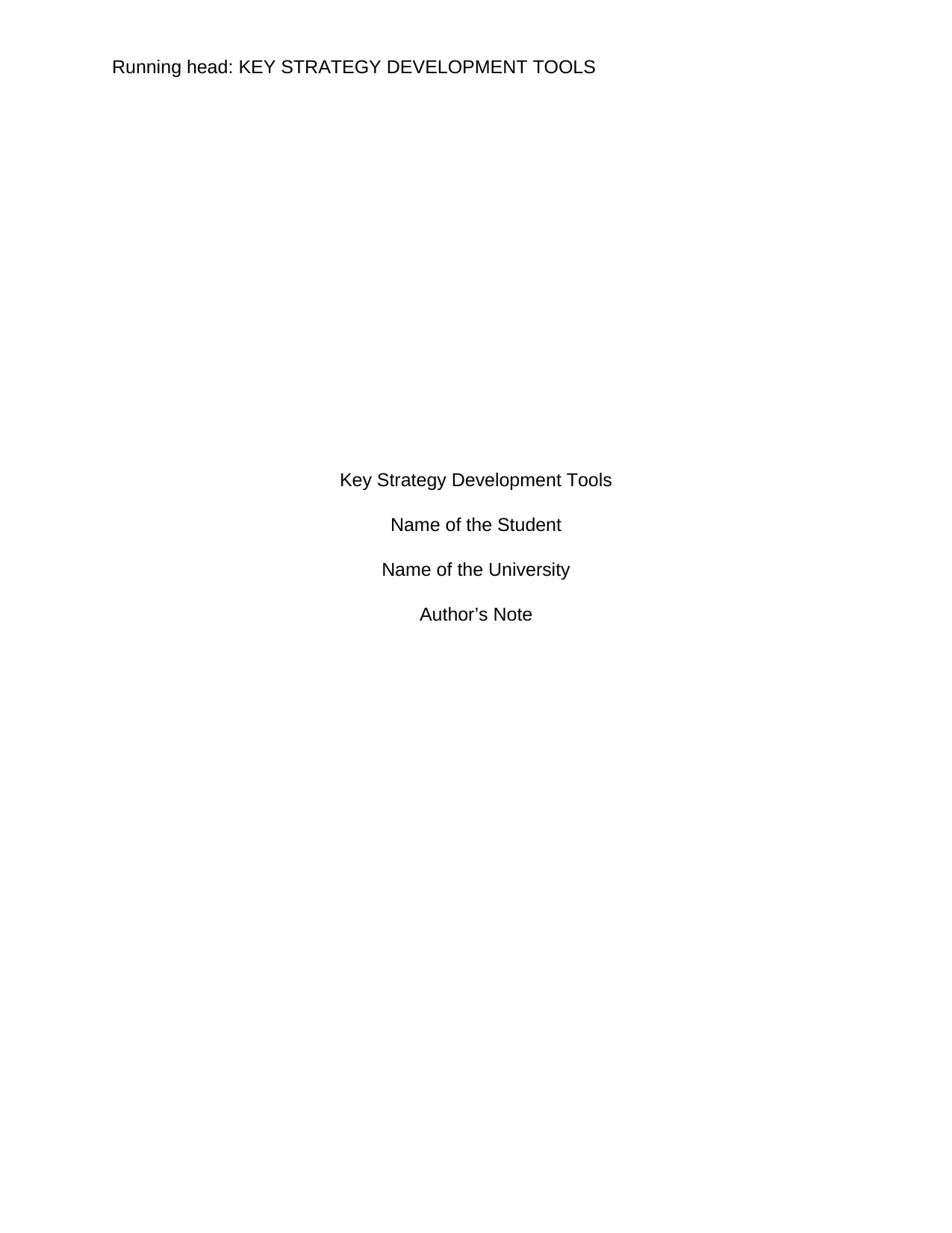
Running head: KEY STRATEGY DEVELOPMENT TOOLS
Key Strategy Development Tools
Name of the Student
Name of the University
Author’s Note
Key Strategy Development Tools
Name of the Student
Name of the University
Author’s Note
Secure Best Marks with AI Grader
Need help grading? Try our AI Grader for instant feedback on your assignments.
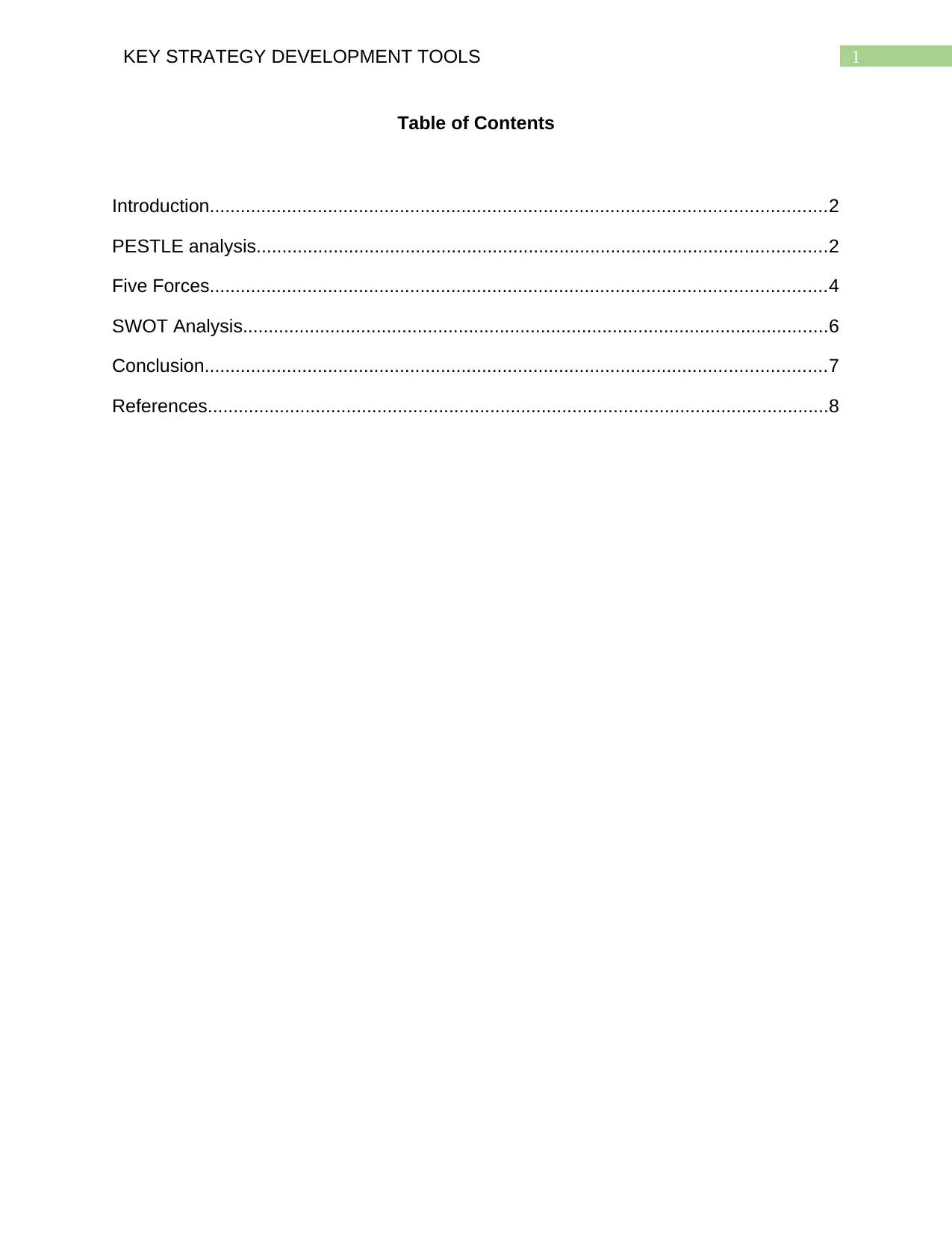
1KEY STRATEGY DEVELOPMENT TOOLS
Table of Contents
Introduction........................................................................................................................2
PESTLE analysis...............................................................................................................2
Five Forces........................................................................................................................4
SWOT Analysis..................................................................................................................6
Conclusion.........................................................................................................................7
References.........................................................................................................................8
Table of Contents
Introduction........................................................................................................................2
PESTLE analysis...............................................................................................................2
Five Forces........................................................................................................................4
SWOT Analysis..................................................................................................................6
Conclusion.........................................................................................................................7
References.........................................................................................................................8
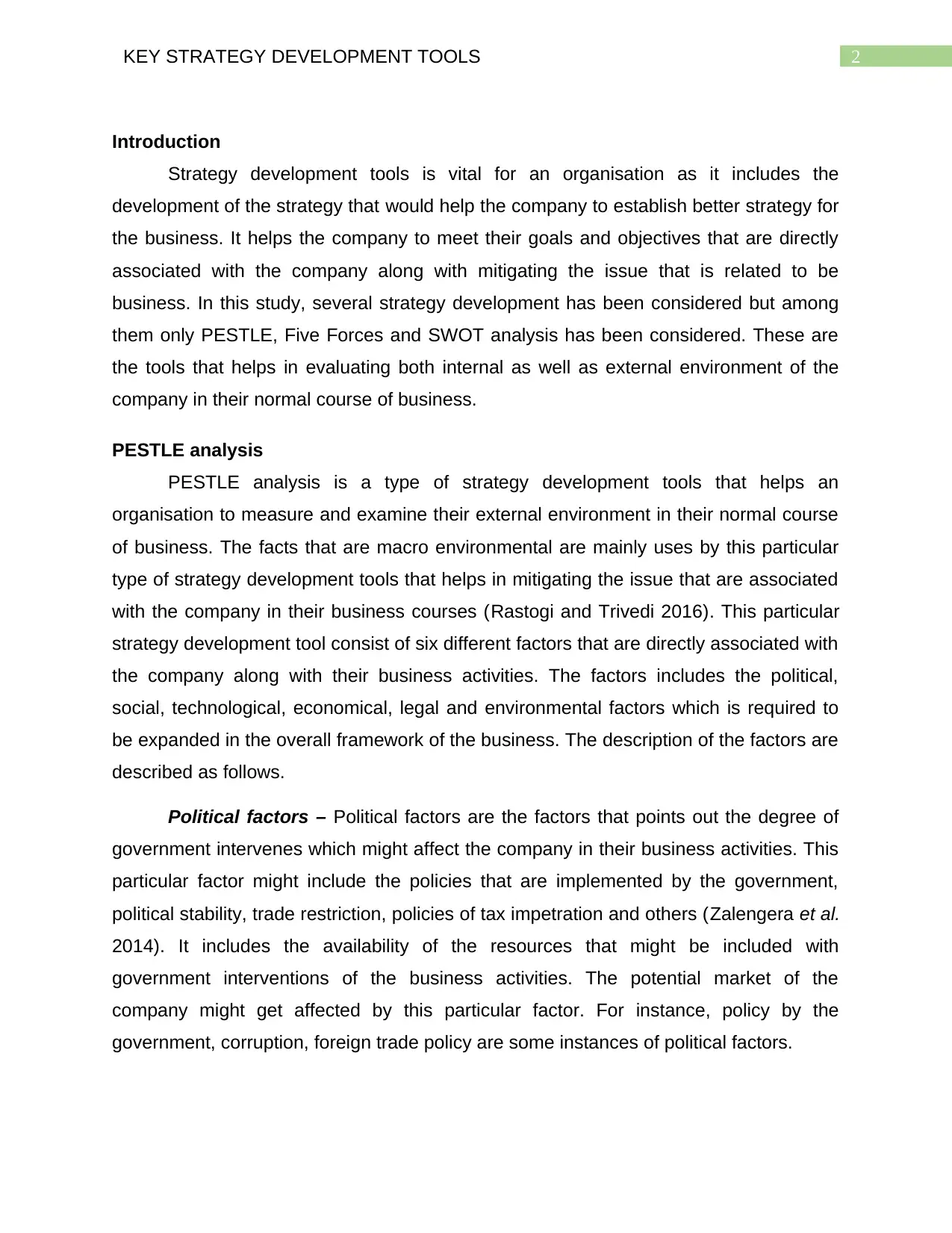
2KEY STRATEGY DEVELOPMENT TOOLS
Introduction
Strategy development tools is vital for an organisation as it includes the
development of the strategy that would help the company to establish better strategy for
the business. It helps the company to meet their goals and objectives that are directly
associated with the company along with mitigating the issue that is related to be
business. In this study, several strategy development has been considered but among
them only PESTLE, Five Forces and SWOT analysis has been considered. These are
the tools that helps in evaluating both internal as well as external environment of the
company in their normal course of business.
PESTLE analysis
PESTLE analysis is a type of strategy development tools that helps an
organisation to measure and examine their external environment in their normal course
of business. The facts that are macro environmental are mainly uses by this particular
type of strategy development tools that helps in mitigating the issue that are associated
with the company in their business courses (Rastogi and Trivedi 2016). This particular
strategy development tool consist of six different factors that are directly associated with
the company along with their business activities. The factors includes the political,
social, technological, economical, legal and environmental factors which is required to
be expanded in the overall framework of the business. The description of the factors are
described as follows.
Political factors – Political factors are the factors that points out the degree of
government intervenes which might affect the company in their business activities. This
particular factor might include the policies that are implemented by the government,
political stability, trade restriction, policies of tax impetration and others (Zalengera et al.
2014). It includes the availability of the resources that might be included with
government interventions of the business activities. The potential market of the
company might get affected by this particular factor. For instance, policy by the
government, corruption, foreign trade policy are some instances of political factors.
Introduction
Strategy development tools is vital for an organisation as it includes the
development of the strategy that would help the company to establish better strategy for
the business. It helps the company to meet their goals and objectives that are directly
associated with the company along with mitigating the issue that is related to be
business. In this study, several strategy development has been considered but among
them only PESTLE, Five Forces and SWOT analysis has been considered. These are
the tools that helps in evaluating both internal as well as external environment of the
company in their normal course of business.
PESTLE analysis
PESTLE analysis is a type of strategy development tools that helps an
organisation to measure and examine their external environment in their normal course
of business. The facts that are macro environmental are mainly uses by this particular
type of strategy development tools that helps in mitigating the issue that are associated
with the company in their business courses (Rastogi and Trivedi 2016). This particular
strategy development tool consist of six different factors that are directly associated with
the company along with their business activities. The factors includes the political,
social, technological, economical, legal and environmental factors which is required to
be expanded in the overall framework of the business. The description of the factors are
described as follows.
Political factors – Political factors are the factors that points out the degree of
government intervenes which might affect the company in their business activities. This
particular factor might include the policies that are implemented by the government,
political stability, trade restriction, policies of tax impetration and others (Zalengera et al.
2014). It includes the availability of the resources that might be included with
government interventions of the business activities. The potential market of the
company might get affected by this particular factor. For instance, policy by the
government, corruption, foreign trade policy are some instances of political factors.
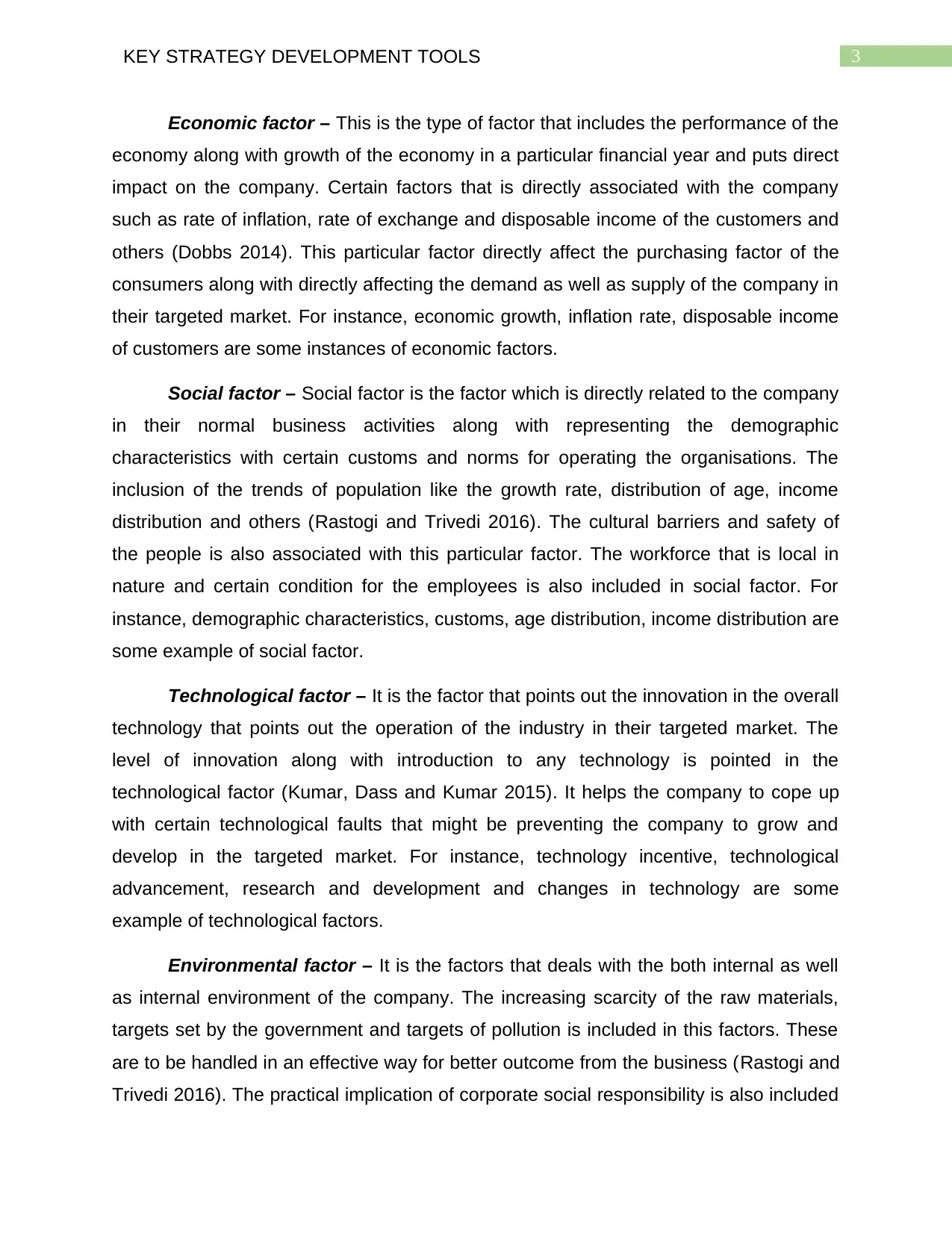
3KEY STRATEGY DEVELOPMENT TOOLS
Economic factor – This is the type of factor that includes the performance of the
economy along with growth of the economy in a particular financial year and puts direct
impact on the company. Certain factors that is directly associated with the company
such as rate of inflation, rate of exchange and disposable income of the customers and
others (Dobbs 2014). This particular factor directly affect the purchasing factor of the
consumers along with directly affecting the demand as well as supply of the company in
their targeted market. For instance, economic growth, inflation rate, disposable income
of customers are some instances of economic factors.
Social factor – Social factor is the factor which is directly related to the company
in their normal business activities along with representing the demographic
characteristics with certain customs and norms for operating the organisations. The
inclusion of the trends of population like the growth rate, distribution of age, income
distribution and others (Rastogi and Trivedi 2016). The cultural barriers and safety of
the people is also associated with this particular factor. The workforce that is local in
nature and certain condition for the employees is also included in social factor. For
instance, demographic characteristics, customs, age distribution, income distribution are
some example of social factor.
Technological factor – It is the factor that points out the innovation in the overall
technology that points out the operation of the industry in their targeted market. The
level of innovation along with introduction to any technology is pointed in the
technological factor (Kumar, Dass and Kumar 2015). It helps the company to cope up
with certain technological faults that might be preventing the company to grow and
develop in the targeted market. For instance, technology incentive, technological
advancement, research and development and changes in technology are some
example of technological factors.
Environmental factor – It is the factors that deals with the both internal as well
as internal environment of the company. The increasing scarcity of the raw materials,
targets set by the government and targets of pollution is included in this factors. These
are to be handled in an effective way for better outcome from the business (Rastogi and
Trivedi 2016). The practical implication of corporate social responsibility is also included
Economic factor – This is the type of factor that includes the performance of the
economy along with growth of the economy in a particular financial year and puts direct
impact on the company. Certain factors that is directly associated with the company
such as rate of inflation, rate of exchange and disposable income of the customers and
others (Dobbs 2014). This particular factor directly affect the purchasing factor of the
consumers along with directly affecting the demand as well as supply of the company in
their targeted market. For instance, economic growth, inflation rate, disposable income
of customers are some instances of economic factors.
Social factor – Social factor is the factor which is directly related to the company
in their normal business activities along with representing the demographic
characteristics with certain customs and norms for operating the organisations. The
inclusion of the trends of population like the growth rate, distribution of age, income
distribution and others (Rastogi and Trivedi 2016). The cultural barriers and safety of
the people is also associated with this particular factor. The workforce that is local in
nature and certain condition for the employees is also included in social factor. For
instance, demographic characteristics, customs, age distribution, income distribution are
some example of social factor.
Technological factor – It is the factor that points out the innovation in the overall
technology that points out the operation of the industry in their targeted market. The
level of innovation along with introduction to any technology is pointed in the
technological factor (Kumar, Dass and Kumar 2015). It helps the company to cope up
with certain technological faults that might be preventing the company to grow and
develop in the targeted market. For instance, technology incentive, technological
advancement, research and development and changes in technology are some
example of technological factors.
Environmental factor – It is the factors that deals with the both internal as well
as internal environment of the company. The increasing scarcity of the raw materials,
targets set by the government and targets of pollution is included in this factors. These
are to be handled in an effective way for better outcome from the business (Rastogi and
Trivedi 2016). The practical implication of corporate social responsibility is also included
Secure Best Marks with AI Grader
Need help grading? Try our AI Grader for instant feedback on your assignments.
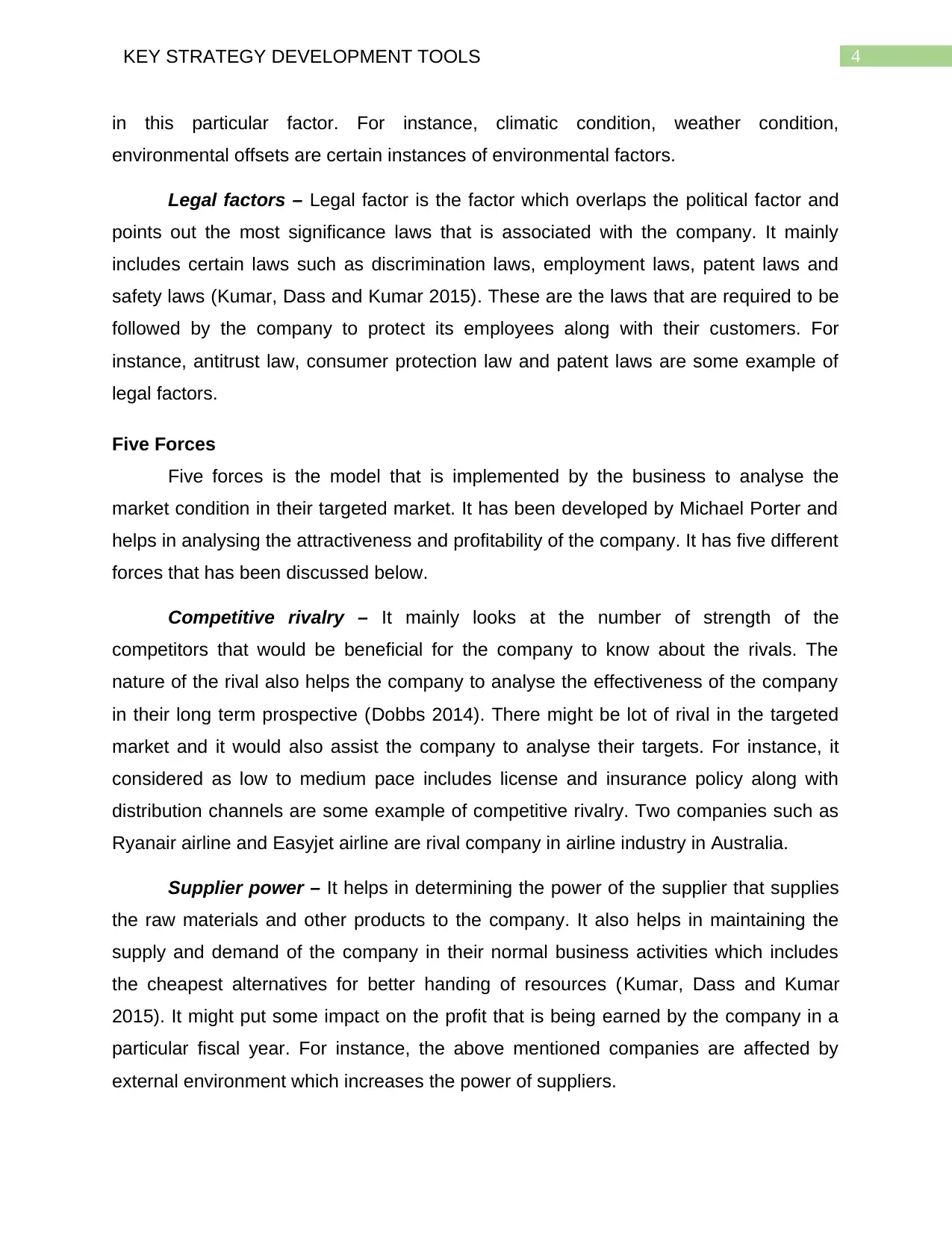
4KEY STRATEGY DEVELOPMENT TOOLS
in this particular factor. For instance, climatic condition, weather condition,
environmental offsets are certain instances of environmental factors.
Legal factors – Legal factor is the factor which overlaps the political factor and
points out the most significance laws that is associated with the company. It mainly
includes certain laws such as discrimination laws, employment laws, patent laws and
safety laws (Kumar, Dass and Kumar 2015). These are the laws that are required to be
followed by the company to protect its employees along with their customers. For
instance, antitrust law, consumer protection law and patent laws are some example of
legal factors.
Five Forces
Five forces is the model that is implemented by the business to analyse the
market condition in their targeted market. It has been developed by Michael Porter and
helps in analysing the attractiveness and profitability of the company. It has five different
forces that has been discussed below.
Competitive rivalry – It mainly looks at the number of strength of the
competitors that would be beneficial for the company to know about the rivals. The
nature of the rival also helps the company to analyse the effectiveness of the company
in their long term prospective (Dobbs 2014). There might be lot of rival in the targeted
market and it would also assist the company to analyse their targets. For instance, it
considered as low to medium pace includes license and insurance policy along with
distribution channels are some example of competitive rivalry. Two companies such as
Ryanair airline and Easyjet airline are rival company in airline industry in Australia.
Supplier power – It helps in determining the power of the supplier that supplies
the raw materials and other products to the company. It also helps in maintaining the
supply and demand of the company in their normal business activities which includes
the cheapest alternatives for better handing of resources (Kumar, Dass and Kumar
2015). It might put some impact on the profit that is being earned by the company in a
particular fiscal year. For instance, the above mentioned companies are affected by
external environment which increases the power of suppliers.
in this particular factor. For instance, climatic condition, weather condition,
environmental offsets are certain instances of environmental factors.
Legal factors – Legal factor is the factor which overlaps the political factor and
points out the most significance laws that is associated with the company. It mainly
includes certain laws such as discrimination laws, employment laws, patent laws and
safety laws (Kumar, Dass and Kumar 2015). These are the laws that are required to be
followed by the company to protect its employees along with their customers. For
instance, antitrust law, consumer protection law and patent laws are some example of
legal factors.
Five Forces
Five forces is the model that is implemented by the business to analyse the
market condition in their targeted market. It has been developed by Michael Porter and
helps in analysing the attractiveness and profitability of the company. It has five different
forces that has been discussed below.
Competitive rivalry – It mainly looks at the number of strength of the
competitors that would be beneficial for the company to know about the rivals. The
nature of the rival also helps the company to analyse the effectiveness of the company
in their long term prospective (Dobbs 2014). There might be lot of rival in the targeted
market and it would also assist the company to analyse their targets. For instance, it
considered as low to medium pace includes license and insurance policy along with
distribution channels are some example of competitive rivalry. Two companies such as
Ryanair airline and Easyjet airline are rival company in airline industry in Australia.
Supplier power – It helps in determining the power of the supplier that supplies
the raw materials and other products to the company. It also helps in maintaining the
supply and demand of the company in their normal business activities which includes
the cheapest alternatives for better handing of resources (Kumar, Dass and Kumar
2015). It might put some impact on the profit that is being earned by the company in a
particular fiscal year. For instance, the above mentioned companies are affected by
external environment which increases the power of suppliers.
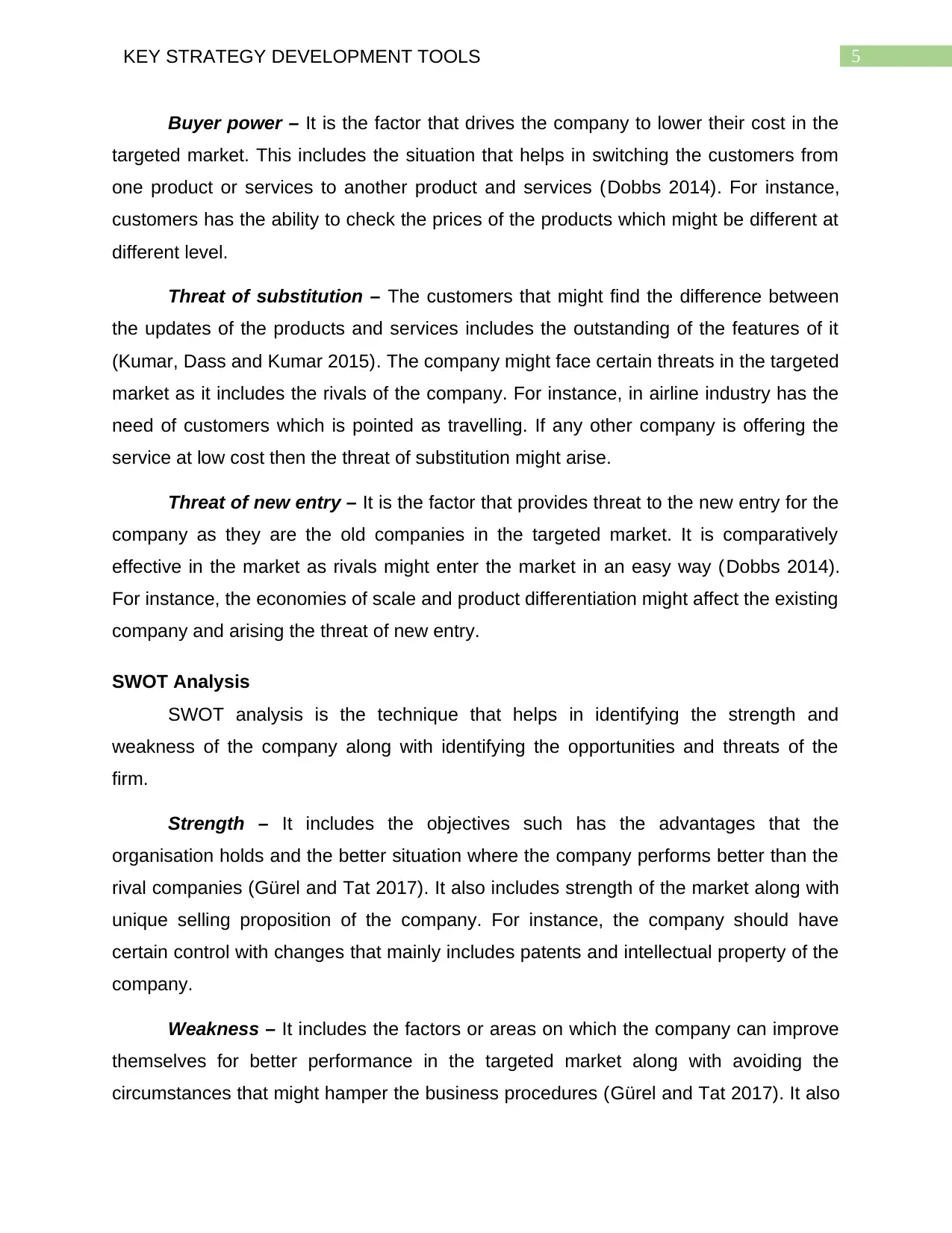
5KEY STRATEGY DEVELOPMENT TOOLS
Buyer power – It is the factor that drives the company to lower their cost in the
targeted market. This includes the situation that helps in switching the customers from
one product or services to another product and services (Dobbs 2014). For instance,
customers has the ability to check the prices of the products which might be different at
different level.
Threat of substitution – The customers that might find the difference between
the updates of the products and services includes the outstanding of the features of it
(Kumar, Dass and Kumar 2015). The company might face certain threats in the targeted
market as it includes the rivals of the company. For instance, in airline industry has the
need of customers which is pointed as travelling. If any other company is offering the
service at low cost then the threat of substitution might arise.
Threat of new entry – It is the factor that provides threat to the new entry for the
company as they are the old companies in the targeted market. It is comparatively
effective in the market as rivals might enter the market in an easy way (Dobbs 2014).
For instance, the economies of scale and product differentiation might affect the existing
company and arising the threat of new entry.
SWOT Analysis
SWOT analysis is the technique that helps in identifying the strength and
weakness of the company along with identifying the opportunities and threats of the
firm.
Strength – It includes the objectives such has the advantages that the
organisation holds and the better situation where the company performs better than the
rival companies (Gürel and Tat 2017). It also includes strength of the market along with
unique selling proposition of the company. For instance, the company should have
certain control with changes that mainly includes patents and intellectual property of the
company.
Weakness – It includes the factors or areas on which the company can improve
themselves for better performance in the targeted market along with avoiding the
circumstances that might hamper the business procedures (Gürel and Tat 2017). It also
Buyer power – It is the factor that drives the company to lower their cost in the
targeted market. This includes the situation that helps in switching the customers from
one product or services to another product and services (Dobbs 2014). For instance,
customers has the ability to check the prices of the products which might be different at
different level.
Threat of substitution – The customers that might find the difference between
the updates of the products and services includes the outstanding of the features of it
(Kumar, Dass and Kumar 2015). The company might face certain threats in the targeted
market as it includes the rivals of the company. For instance, in airline industry has the
need of customers which is pointed as travelling. If any other company is offering the
service at low cost then the threat of substitution might arise.
Threat of new entry – It is the factor that provides threat to the new entry for the
company as they are the old companies in the targeted market. It is comparatively
effective in the market as rivals might enter the market in an easy way (Dobbs 2014).
For instance, the economies of scale and product differentiation might affect the existing
company and arising the threat of new entry.
SWOT Analysis
SWOT analysis is the technique that helps in identifying the strength and
weakness of the company along with identifying the opportunities and threats of the
firm.
Strength – It includes the objectives such has the advantages that the
organisation holds and the better situation where the company performs better than the
rival companies (Gürel and Tat 2017). It also includes strength of the market along with
unique selling proposition of the company. For instance, the company should have
certain control with changes that mainly includes patents and intellectual property of the
company.
Weakness – It includes the factors or areas on which the company can improve
themselves for better performance in the targeted market along with avoiding the
circumstances that might hamper the business procedures (Gürel and Tat 2017). It also
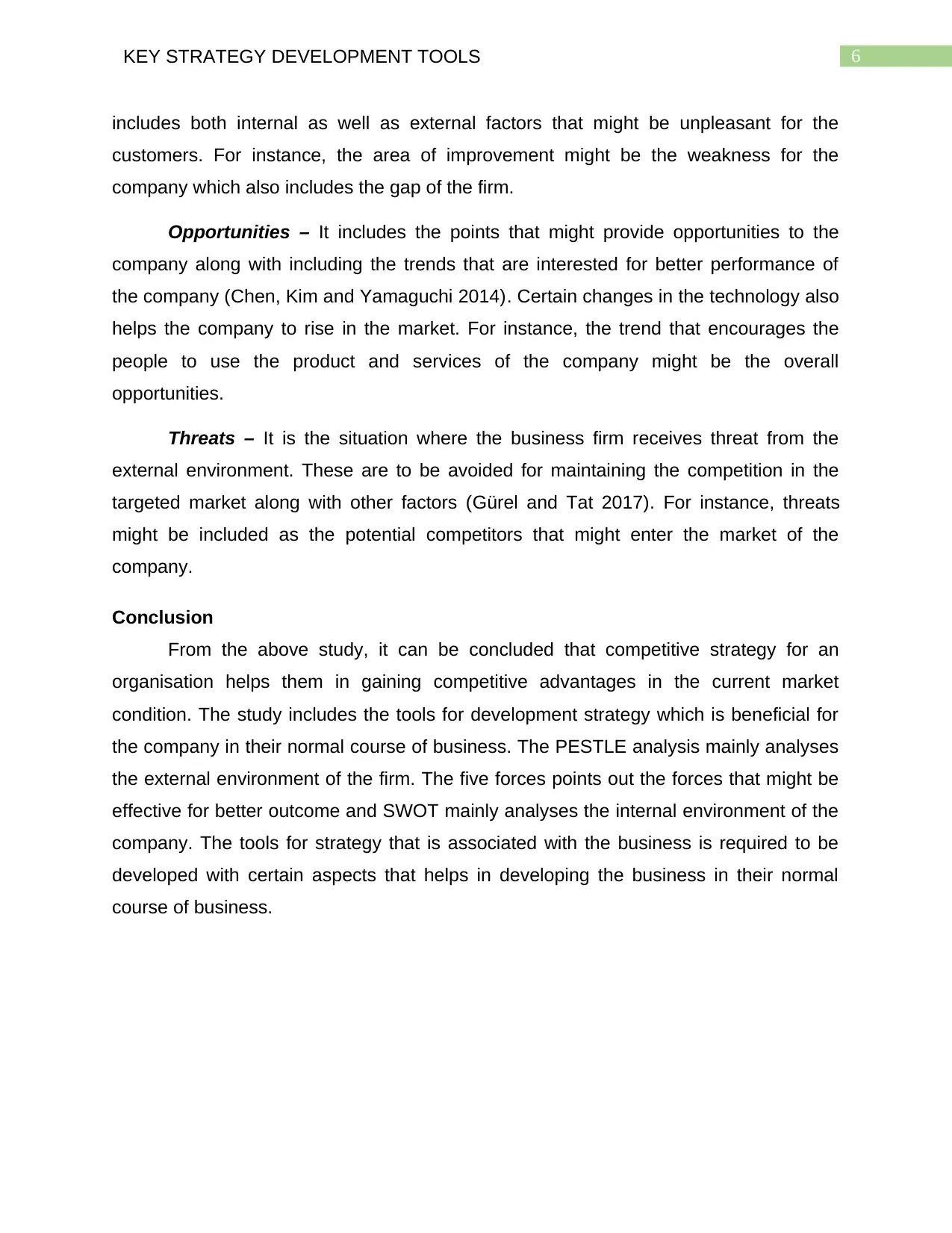
6KEY STRATEGY DEVELOPMENT TOOLS
includes both internal as well as external factors that might be unpleasant for the
customers. For instance, the area of improvement might be the weakness for the
company which also includes the gap of the firm.
Opportunities – It includes the points that might provide opportunities to the
company along with including the trends that are interested for better performance of
the company (Chen, Kim and Yamaguchi 2014). Certain changes in the technology also
helps the company to rise in the market. For instance, the trend that encourages the
people to use the product and services of the company might be the overall
opportunities.
Threats – It is the situation where the business firm receives threat from the
external environment. These are to be avoided for maintaining the competition in the
targeted market along with other factors (Gürel and Tat 2017). For instance, threats
might be included as the potential competitors that might enter the market of the
company.
Conclusion
From the above study, it can be concluded that competitive strategy for an
organisation helps them in gaining competitive advantages in the current market
condition. The study includes the tools for development strategy which is beneficial for
the company in their normal course of business. The PESTLE analysis mainly analyses
the external environment of the firm. The five forces points out the forces that might be
effective for better outcome and SWOT mainly analyses the internal environment of the
company. The tools for strategy that is associated with the business is required to be
developed with certain aspects that helps in developing the business in their normal
course of business.
includes both internal as well as external factors that might be unpleasant for the
customers. For instance, the area of improvement might be the weakness for the
company which also includes the gap of the firm.
Opportunities – It includes the points that might provide opportunities to the
company along with including the trends that are interested for better performance of
the company (Chen, Kim and Yamaguchi 2014). Certain changes in the technology also
helps the company to rise in the market. For instance, the trend that encourages the
people to use the product and services of the company might be the overall
opportunities.
Threats – It is the situation where the business firm receives threat from the
external environment. These are to be avoided for maintaining the competition in the
targeted market along with other factors (Gürel and Tat 2017). For instance, threats
might be included as the potential competitors that might enter the market of the
company.
Conclusion
From the above study, it can be concluded that competitive strategy for an
organisation helps them in gaining competitive advantages in the current market
condition. The study includes the tools for development strategy which is beneficial for
the company in their normal course of business. The PESTLE analysis mainly analyses
the external environment of the firm. The five forces points out the forces that might be
effective for better outcome and SWOT mainly analyses the internal environment of the
company. The tools for strategy that is associated with the business is required to be
developed with certain aspects that helps in developing the business in their normal
course of business.
Paraphrase This Document
Need a fresh take? Get an instant paraphrase of this document with our AI Paraphraser
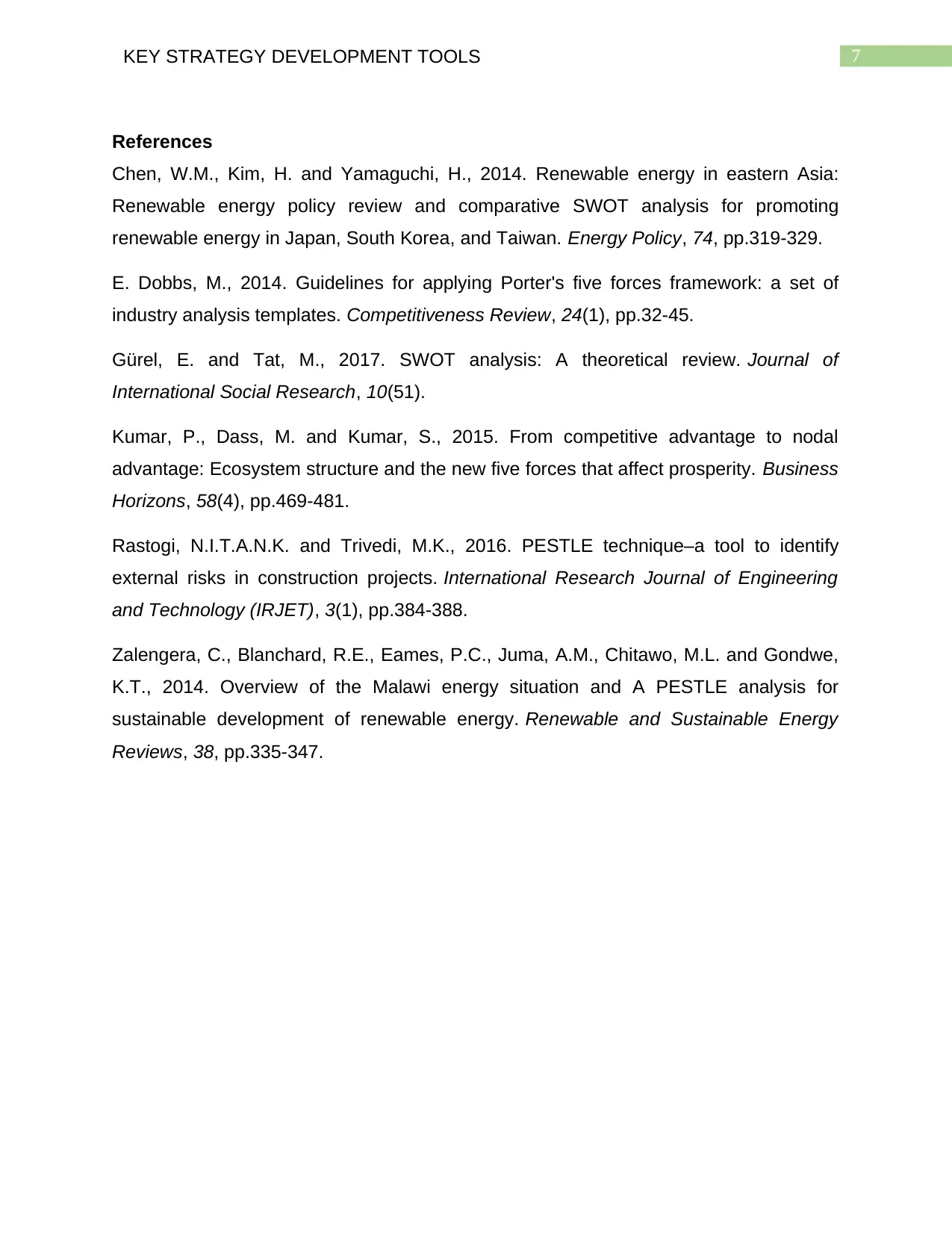
7KEY STRATEGY DEVELOPMENT TOOLS
References
Chen, W.M., Kim, H. and Yamaguchi, H., 2014. Renewable energy in eastern Asia:
Renewable energy policy review and comparative SWOT analysis for promoting
renewable energy in Japan, South Korea, and Taiwan. Energy Policy, 74, pp.319-329.
E. Dobbs, M., 2014. Guidelines for applying Porter's five forces framework: a set of
industry analysis templates. Competitiveness Review, 24(1), pp.32-45.
Gürel, E. and Tat, M., 2017. SWOT analysis: A theoretical review. Journal of
International Social Research, 10(51).
Kumar, P., Dass, M. and Kumar, S., 2015. From competitive advantage to nodal
advantage: Ecosystem structure and the new five forces that affect prosperity. Business
Horizons, 58(4), pp.469-481.
Rastogi, N.I.T.A.N.K. and Trivedi, M.K., 2016. PESTLE technique–a tool to identify
external risks in construction projects. International Research Journal of Engineering
and Technology (IRJET), 3(1), pp.384-388.
Zalengera, C., Blanchard, R.E., Eames, P.C., Juma, A.M., Chitawo, M.L. and Gondwe,
K.T., 2014. Overview of the Malawi energy situation and A PESTLE analysis for
sustainable development of renewable energy. Renewable and Sustainable Energy
Reviews, 38, pp.335-347.
References
Chen, W.M., Kim, H. and Yamaguchi, H., 2014. Renewable energy in eastern Asia:
Renewable energy policy review and comparative SWOT analysis for promoting
renewable energy in Japan, South Korea, and Taiwan. Energy Policy, 74, pp.319-329.
E. Dobbs, M., 2014. Guidelines for applying Porter's five forces framework: a set of
industry analysis templates. Competitiveness Review, 24(1), pp.32-45.
Gürel, E. and Tat, M., 2017. SWOT analysis: A theoretical review. Journal of
International Social Research, 10(51).
Kumar, P., Dass, M. and Kumar, S., 2015. From competitive advantage to nodal
advantage: Ecosystem structure and the new five forces that affect prosperity. Business
Horizons, 58(4), pp.469-481.
Rastogi, N.I.T.A.N.K. and Trivedi, M.K., 2016. PESTLE technique–a tool to identify
external risks in construction projects. International Research Journal of Engineering
and Technology (IRJET), 3(1), pp.384-388.
Zalengera, C., Blanchard, R.E., Eames, P.C., Juma, A.M., Chitawo, M.L. and Gondwe,
K.T., 2014. Overview of the Malawi energy situation and A PESTLE analysis for
sustainable development of renewable energy. Renewable and Sustainable Energy
Reviews, 38, pp.335-347.
1 out of 8
Related Documents
Your All-in-One AI-Powered Toolkit for Academic Success.
+13062052269
info@desklib.com
Available 24*7 on WhatsApp / Email
![[object Object]](/_next/static/media/star-bottom.7253800d.svg)
Unlock your academic potential
© 2024 | Zucol Services PVT LTD | All rights reserved.





